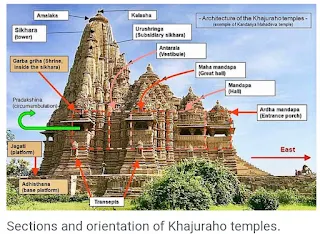Most Khajuraho temples were built between 885 CE and 1000 CE by the Chandela dynasty.[2][3] Historical records note that the Khajuraho temple site had 85 temples by the 12th century, spread over 20 square kilometres (7.7 sq mi). Of these, only about 25 temples have survived, spread over six square kilometres (2.3 sq mi).[3] Of the surviving temples, the Kandariya Mahadeva Temple is decorated with a profusion of sculptures with intricate details, symbolism, and expressiveness of ancient Indian art.[4] The temple complex was forgotten and overgrown by the jungle until 1838 when Captain T.S. Burt, a British engineer, visited the complex and reported his findings in the Journal of the Asiatic Society of Bengal
Location
he Khajuraho monuments are located in the Indian state of Madhya Pradesh, in Chatarpur district, about 620 kilometres (385 mi) southeast of New Delhi. The temples are located near a small town also known as Khajuraho,[14] with a population of about 24,481 people (2011 Census).
Khajuraho is served by Civil Aerodrome Khajuraho (IATA Code: HJR), with services to Delhi, Agra, Varanasi and Mumbai.[15] The site is also linked by the Indian Railways service, with the railway station located approximately six kilometres from the entrance to the monuments.
Historical overview
The Khajuraho group of monuments was built during the rule of the Chandela dynasty. The building activity started almost immediately after the rise of their power, throughout their kingdom to be later known as Bundelkhand.[16] Most temples were built during the reigns of the Hindu kings Yashovarman and Dhanga. Yashovarman's legacy is best exhibited by the Lakshmana Temple. Vishvanatha temple best highlights King Dhanga's reign.[17]: 22 The largest and currently most famous surviving temple is Kandariya Mahadeva built in the reign of King Vidyadhara.[18] The temple inscriptions suggest many of the currently surviving temples were complete between 970 and 1030 AD, with further temples completed during the following decades.
The Khajuraho temples were built about 35 miles from the medieval city of Mahoba,[19] the capital of the Chandela dynasty, in the Kalinjar region. In ancient and medieval literature, their kingdom has been referred to as Jijhoti, Jejahoti, Chih-chi-to and Jejakabhukti.













0 Comments